
Wayn-Gurr Derrk Indigenous Community Gardens, Peter Lalor South, Mt Helen Campus
Wayn-Gurr Derrk is Wadawurrung language for 'good ground'. The University’s Commercial Services and the Aboriginal Education Centre (AEC) are working together on this unique project. Wayn-Gurr Derrk provides our students in residence, as well as the wider University community with access and education on local indigenous food plants, and in time they will be able to try the food produced and utilise in their cooking and meals. The garden makes an important contribution towards the Federation University Reconciliation Action Plan in supporting and building relationships with our Aboriginal and Torres Strait Islander students and promoting the Indigenous culture to all students. Plants in the garden include Black Plum, Small Leaved Tamarind, Lemon Myrtle, and Red Back Ginger, as well as others, providing a selection of herbs and fruits which can serve a variety of uses. Aboriginal cultures are for all Australians to celebrate and feel proud of. The garden aims to share knowledge with everyone working together to increase respect and pride on our journey of reconciliation. | 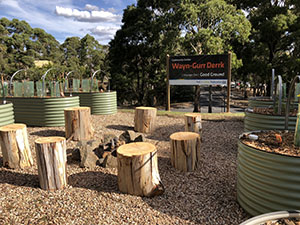
|
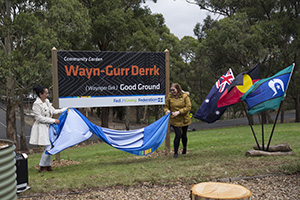
|
Plants and information
Native Guava (Eupomatia laurina)
- Native Guava is a very sweet, aromatic fruit often used as a spice-fruit in cooking, being included in beverages, jams and desserts.
- Pale, heavily scented flowers that have no petals appear in summer followed by urn-shaped fruit 2-3cm in diameter.
- Fruits ripen in winter and are ready to eat when they turn from green to brown and are soft to squeeze.
- They can be used to make Native Guava jelly and jams, and are quite good to eat raw.
- Dried fruit can be crushed and used as an Australian spice.
- Foliage takes on attractive coppery tones in the cooler weather of winter and spring.
- Benefits from mulching and additional watering in dry periods.
- Protect from hot drying winds.
HEIGHT 3-5M, WIDTH 2-3M | PART SHADE | JAMS/JELLIES | BIRD ATTRACTING | EDIBLE PLANT
Blue Lilly Pilly (Syzygium oleosum)
- The Blue Lilly Pilly produces clusters of highly attractive blue-purple berries that are crunchy and light with a mild sweetness.
- With hints of ginger and lavender flavours, they may be enjoyed fresh or used in jams, jellies, sauces, syrups, confectionery and wine.
- Expect a long flowering season (spring to winter) of white-cream flowers.
- This is a hardy species that will tolerate dry conditions once established, but prefers rich well drained soils to establish.
- Blue Lilly Pilly grows in full sun or part shade and makes a great edible and ornamental hedge.
HEIGHT 4-7M, WIDTH 4M | FULL SUN | JAMS/JELLIES | BIRD ATTRACTING | EDIBLE PLANT
Black Plum (Diospyros australis)
- An attractive small to medium tree with attractive glossy green leaves which are yellowish underneath and a prominent yellow mid vein.
- Black Plum is also known as Black Ebony and it is a rainforest tree that enjoys moist soil, and can tolerate heavy shade.
- Does best with wind and afternoon sun protection.
- Small cream yellow flowers are borne October to December followed by black shiny fruits which are most edible when soft.
- Fruit is 10-15mm and ripens in autumn.
- The Black Plum also has fire retardant properties, making it a valuable inclusion around houses in bush areas.
- Pollination is improved by planting two or more.
HEIGHT 4-10M, WIDTH 4-7M | FULL SUN/PART SHADE | JAMS/JELLIES | BIRD ATTRACTING | EDIBLE PLANT
Davidson’s Plum (Davidsonia jerseyana)
- Davidson’s plum is also known as Mullumbimby plum.
- Fruits are large, purple and plum-like forming clusters on the trunk.
- Fruiting occurs between November to February and individual trees are capable of producing many kilos of fruit.
- The red fleshed plums are pleasantly sour and very high in antioxidants and vitamins.
- They are delicious and lend themselves to both sweet and savoury jams and meat sauces. They can also be made into wine.
- Davidson’s Plum is tall and slender and can be planted in narrow places.
- New growth is attractive and tinged red. It likes protection from full sun and wind when young, adequate soil moisture, and good soil nutrition.
HEIGHT 4-8M, WIDTH 3-4M | FULL SUN/PART SHADE | JAMS | BIRD ATTRACTING | EDIBLE PLANT
Small-leaved Tamarind (Diploglottis campbellii)
- Small-leaved Tamarind is a small, dense tree that produces large orange fruits with a delicious, tangy pulp.
- Watch for small, cream-brown flowers in November to January, turning to large (up to 6cm across) yellow-brown capsules in February and April.
- These will split open when ripe, revealing the bright red fruit flesh.
- The flavour is refreshingly tart with a distinctive taste that lends well to both sweet and savoury dishes.
- Recipe favourites include jams, jellies, sauces, fruit chutneys, spreads and coulis. It also makes a great accompaniment for cheeses and cold meets.
- Keep it watered through the dry season and apply an organic or slow-release fertiliser in early Spring.
- This is a beautiful ornamental shade tree that reaches heights of 6-8m in the garden, but may be kept in a pot with regular pruning and care.
HEIGHT 6-8M| FULL SUN/PART SHADE | JAMS/JELLIES | BIRD ATTRACTING | EDIBLE PLANT
Lemon Myrtle (Backhousia citriodora)
- Sometimes called “Queen of the Lemon Herbs”, Lemon Myrtle boasts an intensely citrus fragrance and flavour.
- Pluck leaves as needed for flavouring teas, syrups, glazes, cakes, biscuits, dressings, sauces, ice creams, dips and meat dishes.
- Leaves may be used fresh or dried for storage.
- Lemon Myrtle is a rainforest species that prefers warm conditions sheltered from frost and cold winds.
- With its elegant branches of green foliage and fragrant, creamy Autumn flowers, the Lemon Myrtle makes the perfect ornamental shade tree or large shrub for any garden.
- Terrific as a pot specimen in a kitchen garden too.
HEIGHT 3-8M, WIDTH 3-5M| FULL SUN/PART SHADE | BIRD ATTRACTING | EDIBLE PLANT
Bignay (Antidesma bunius)
- Bignay is a medium tree outside of tropical areas.
- Fruits are borne in grape-like clusters which are extremely showy because the berries ripen unevenly.
- Bignay fruit has a sour taste similar to that of the cranberry when immature and white in colour and a tart but sweet taste when ripe and red and black.
- Fruits can be eaten raw or used for making jam.
- Bignay makes a sour sauce that is excellent syrup and has even been fermented into wine.
- The dark green and glossy, alternative leaves make the tree an attractive ornamental.
- Protect from drying winds and frost.
HEIGHT 3-8M, WIDTH 3-5M| FULL SUN/PART SHADE | JAMS/JELLIES | BIRD ATTRACTING | EDIBLE PLANT
Large-leaved Tamarind (Diploglottis australis)
- Large Leaf Tamarind is a slender, palm-like gully tree that bears sweet, tart fruits prolifically each season.
- Creamy brown flowers form in spring, maturing from October to January.
- Fruits will fall from the tree when ripe, and should be collected as soon as possible as they are a favourite of ants, birds, bats and other garden creatures.
- Shelter the Large Leaf tamarind from strong winds and frosts.
- It prefers moist soil throughout the year, but can thrive in a range of soil types.
- This tree can grow to 8m tall in a domestic garden but larger in rainforest conditions.
- Does well in a large pot where it makes an attractive specimen with its large ornamental leaves.
HEIGHT 8M, WIDTH 6M| PART SHADE | JAMS/JELLIES | BIRD ATTRACTING | EDIBLE PLANT
Tasmanian Native Pepper (Tasmannia lanceolata)
- Mountain Pepper is an evergreen shrub used in Aboriginal cuisine and traditional medicine.
- Both leaves and berries may be added fresh or dried to curries, sauces and dressings for a peppery flavour.
- Flowers may be enjoyed fresh in salads, or as a spicy garnish for a variety of dishes.
- Dry berries make a pungent native substitute for black pepper.
- Harvest the leaves year-round as desired, and the ripe (black) berries between March and May.
- This species grows best in lime-free, fertile, moist and well-drained soils in semi-shade positions.
- Sheltered from hot summer sun and drying winds.
- Condition soil with organic matter before planting, and ensure ground is mulched before summer.
HEIGHT 3-5M, WIDTH 3M| PART SHADE | BIRD ATTRACTING | EDIBLE PLANT
Red Back Ginger (Alpinia caerulea ‘Atherton’)
- A versatile plant traditionally used by the Aboriginal people for food and crafting.
- Natively found in the rainforest understoreys of Northern New South Wales and Southern Queensland – this red leaved variety comes from the Atherton Tablelands region near Cairns.
- Like other ginger roots, this one may be used in savoury dishes, desserts, jams, marmalades, candies and tea.
- Fragrant white flowers appear from late spring to early summer, eventually leaving blue berries that may be picked and eaten straight off the stem. (Spit the seeds out).
HEIGHT 2M, WIDTH 1M| PART SHADE | JAMS/JELLIES | BIRD ATTRACTING | EDIBLE PLANT
Ruby Saltbush (Enchylaena Tomentosa)This member of the world-wide Chenopodiaceae family has many common names, among them Ruby Saltbush and Barrier Saltbush. It occurs in all mainland States. Enchylaena tomentosa is a sub-shrub (that is, a low-growing, semi-woody plant) with procumbent or ascending pubescent, trailing branches which may grow to 1m long. A height of 1m is occasionally attained, however, plants are often less than half this size and some forms are prostrate. The evergreen leaves, which are cylindrical, semi-succulent and up to 2cm long, are covered with fine white hairs (tomentose) , giving the plant an attractive grey appearance overall. The single, axillary flowers are insignificant and occur from spring to early summer and autumn. These are followed by very showy, small (5mm diameter) fruits which are red when ripe. The fruits are depressed-globular and succulent and change from green to yellow prior to ripening. It is usual for the differing colour stages to be present on a plant at the one time, adding greatly to the visual impact Enchylaena tomentosa is found over a wide range of poor soils from coastal, partially stabilised, dune sands near the Southern Ocean in South Australia, where it may be planed by salt and sand-bearing winds, to riverine clay loams, often in saline depressions, and to the deep siliceous, sandy soils in many semi-arid regions of the continent. The species is recorded in salt marsh habitats in tropical, sub-tropical, and temperate regions. The leaf type of E. tomentosa is typical of many chenopods. Reduced size and succulence are adaptations to nutritionally poor soils and the leaf tomentum reflects considerable heat which may otherwise be damaging to cell tissue. The species is propagated successfully from seed or cuttings. Seed should be cleaned by removing the succulent tissue of the fruit prior to sowing and germination should occur in one to four weeks. A well-drained medium, kept moist without excessive overhead watering, is desirable for cuttings. Source: Text by Barrie Hadlow, ANBG (1986) HEIGHT 1M| FULL SUN | DROUGHT TOLERANT| EDIBLE PLANT | 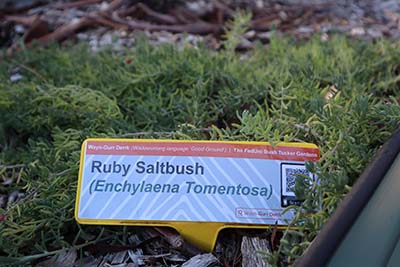 |
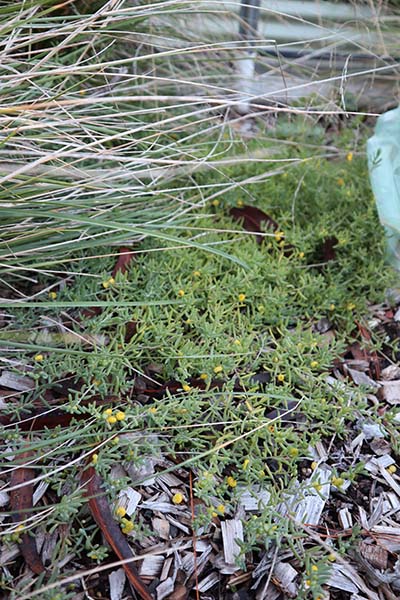
| |
Large Tussock-Grass (Poa Labillardieri)Poa labillardierei (Common Tussock-grass) is an attractive, low maintenance, native ornamental. Poa labillardierei can be found in southern and eastern Australia including Tasmania, particularly in open forest communities, grassy woodland communities and in moister areas on low slopes and valley floors that are frequently wet. Poa labillardierei is a dense coarsely tufted grasses and can reach a height of 120 cm. The greyish-green or blue-green leaves are long and slender with rolled or flat blades. Poa labillardierei flowers in spring to summer. The flower heads are like delicate plumes that extend above the highly ornamental foliage making the species very attractive for horticulture. Poa labillardierei can be propagated by division and germinates readily from seed, into prepared soil in autumn and winter. The seedlings cannot grow in an area of continuous dry climate and needs moist soil to establish. The seeds can germinate in frost and can tolerate a temperature in the 0 to -5 °C range. It can grow in clay loam, heavy clay, loam, sandy loam and sandy clay loam of medium to high fertility. Due to its fast growth rate and shallow root system plants establishes quickly. Once established, it needs very low maintenance and no irrigation. Poa labillardierei regenerates well after burning but the fire should not be very hot for a long time. Poa labillardierei does not appear have any major diseases or parasites. While it is not considered palatable it can be damaged by grazing animals such as rabbits and kangaroos. Source: Saiba Sharmeen, Volunteer Botanical Training Program Participant 2016 HEIGHT 1.2M | FULL SUN | DROUGHT TOLERANT | NON EDIBLE PLANT | 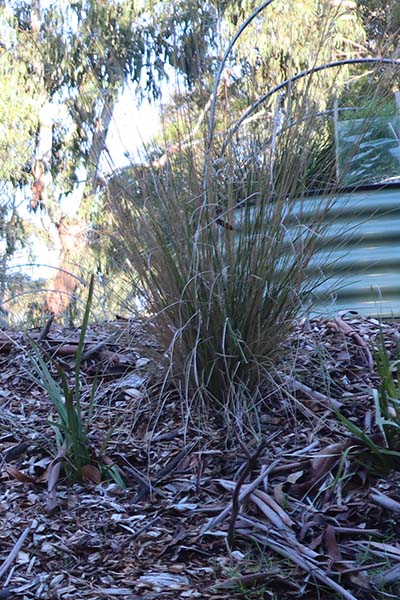
|
Pale Vanilla Lily (Arthropodium milleflorum)
Arthropodium milleflorum is a tuberous perennial herb belonging to the Asparagaceae family. It is commonly known as the Plain Vanilla Lily, due to the slight scent emitted from the flowers.
The species has a wide distribution along the east coast, from Queensland to South Australia and Tasmania. It is particularly prevalent on the Southern Tablelands (including the ACT) and in eastern New South Wales. It favours moist, grassy, sheltered slopes in open eucalypt forest, but can also be found in woodland, montane forest, and other grassland. It is listed as endangered in South Australia due to illegal collection for the horticulture trade, but is not considered at risk elsewhere.
The flowers appear between November and February on spreading or branching stems growing to 1 m. The flowers are hermaphroditic and consist of six white-lilac petals, purple anthers and distinctive white or cream hairy filaments. Fruits develop between December and March and are globular capsules to 5mm in diameter. At the base of the plant are dark green, strappy leaves, which grow to about 60 cm long.
The plant has traditionally been used as a food source by some Aboriginal groups. The tubers are eaten raw or roasted. The flowers are also edible. The presence of flowers may have signalled to hunters that game animals, such as bandicoots (which eat the tubers of this species), were nearby.
The plant has many features which make it ideal for the home garden or landscaping. It is low maintenance, frost tolerant and has relatively low water requirements. Some sources suggest it can go dormant in the drier months, which may make it more resilient to drought. A key feature of the plant is its flowers, which are pleasantly scented, insect attracting, and hang in dainty panicles along the arching stems. It is ideal planted en masse in a meadow, path border, rockery, or under trees, and can also grow in a pot.
In nature the plant is usually propagated by birds or small mammals eating the fruit and spreading the seed. It can self-seed to some extent, but does not become invasive. In cultivation, it is easiest to propagate by seed, which must be collected before they are shed from the fruit. Store seed in a cool, dry, place and sow into seed-raising trays in autumn or early spring. You may also be able to propagate by tuber division, dividing in winter and transplanting in spring.
Source: Freya Clarke, Volunteer Botanical Training Program Participant 2017
HEIGHT 1M| FULL SUN/SHADE | DROUGHT TOLERANT| EDIBLE PLANT
Kangaroo Apple (Solanum laciniatum Aiton)
Solanum is the type genus of the family Solanaceae, which contains such well-known economic plants as the potato, tomato, tobacco, egg plant (aubergine) and many more. In Australia there are 117 species, of which 87 are endemic.
Solanum laciniatum or Kangaroo Apple, a common name shared with the closely related S. aviculare, occurs in temperate regions of New South Wales, the Australian Capital Territory, Victoria, South Australia, Tasmania, New Zealand and associated islands on a range of soil types. It forms a large shrub 4 m high by 5 m wide.
Solanum laciniatum produces two types of foliage: large lance-shaped or irregularly lobed juvenile leaves 300 mm long by 250 mm wide and smaller generally entire lance-shaped adult leaves 150 mm long by about 30-50 mm wide. Both types of leaf are a rich dark green on the upper surface, and a lighter green underneath, with conspicuous veins. They are held on dark green succulent stems, which turn black, then a rough light-brown, with age.
The 5-petalled flowers are 30-50 mm across, bluish-purple, with bright yellow anthers. The flowers appear spasmodically in spring and summer in clusters of 3-5 in the leaf axils. The egg-shaped berries, 20-30 mm long, are a bright orange-yellow with a warty appearance when ripe.
Solanum laciniatum has been cultivated at the Australian National Botanic Gardens since 1969, with no frost damage or major pest or disease problems apparent.
As a fast-growing species, hardy in most soil types and conditions, except salt spray, S. laciniatum is ideally suited as a screen plant, in the understorey of a wind break, or for bank and erosion stabilisation. It has also been used in soils with a high concentration of heavy metals when reclaiming mine wastes. Solanum species are earlier colonisers of cleared or disturbed areas, such as roadways.
In cultivation they are relatively short-lived shrubs, with a life expectancy of 5-6 years in good conditions. Older plants tend to split at the base, which allows wood rot fungi to take hold. Such splitting could be prevented to a large degree by corrective pruning from an early age. Propagation may be from seeds, which require no pre-treatment, or from cuttings taken from spring to autumn.
Since the mid 1960s S. laciniatum and S. aviculare have been cultivated and studied in the USSR, NZ, India, Egypt and other countries. The plants, and in particular the young foliage, contain a series of steroids which are of commercial value as raw material for the manufacture of contraceptives. For the home gardener S. laciniatum is ideal as a quick growing screen plant, while slower shrubs are establishing. It may be hard to obtain through garden centres.
Source: Text by Stuart Donaldson, ANBG (1983)
Old Man Saltbush (Atriplex nummularia)
Old Man Saltbush is a fast-growing shrub commonly used today as a livestock grazing plant. The leaves are also edible, salty in flavour and rich in protein, antioxidants and minerals. This species occurs naturally in WA, SA, NT, VIC, NSW and QLD.
Old Man Saltbush leaves may be treated like a leafy vegetable, enjoyed blanched, sautéed, wrapped around meat or fish, used in salads, or for stuffing poultry. Alternatively, they may be dried and used as a herb or sprinkle.
Harvest Saltbush leaves by simply plucking or cutting, taking only as much as you need. The plant may be left to grow, ensuring a year-round supply.
HEIGHT 2-3M | FULL SUN OR PART SHADE | DROUGHT TOLERANT | ATTRACTS BEES AND INSECTS
Sea Parsley (Apium prostratum var. prostratum)
Sea Parsley is a beachy native that, like young celery shoots, may be used as a flavoursome herb or vegetable. It played an important role for early Australian settlers: eaten by Captain Cook and his crew to prevent scurvy, and regarded as a survival food among the Sydney colonists. Sea Parsley can be found growing wild along the southern coastline of Australia.
Use it as a garnish, finely chopped or in sprigs, to flavour soups, salads, and chicken and seafood dishes. Stems may be enjoyed fresh or blanched (to temper the strong flavours), while seeds may be used as a condiment or cooking spice.
Harvest Sea Parsley the same way you would harvest celery or parsley — pick stems often from the main plant throughout the growing season, or pull out the entire herb by the root.
HEIGHT 30-50cm | FULL SUN OR PART SHADE | DROUGHT TOLERANT | TOLERATES SANDY SOIL